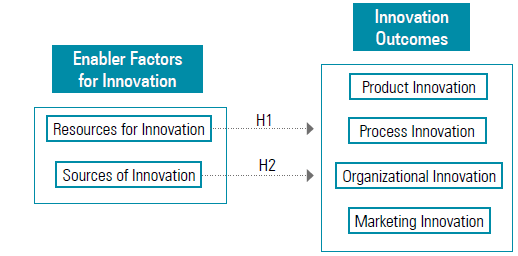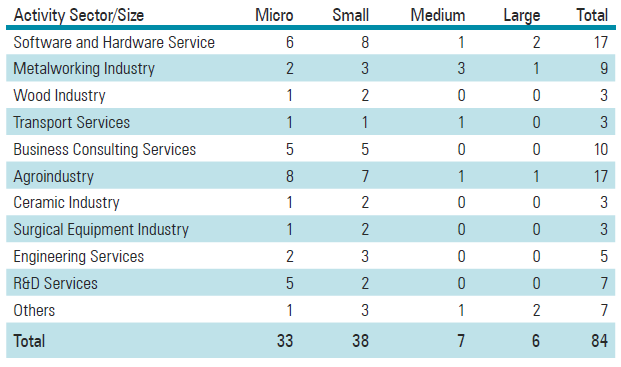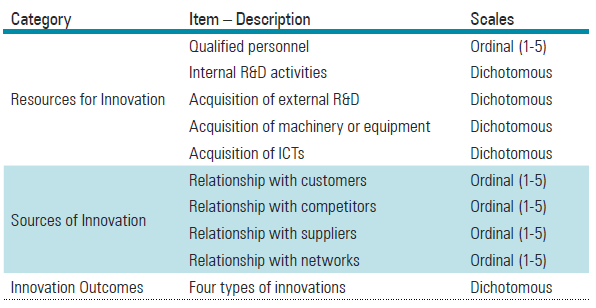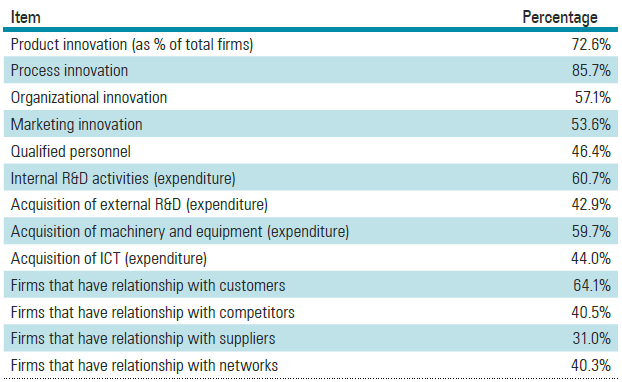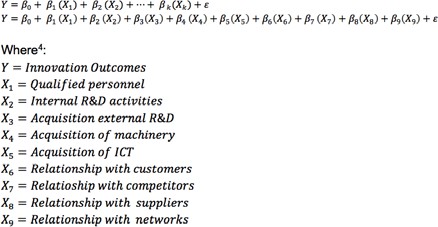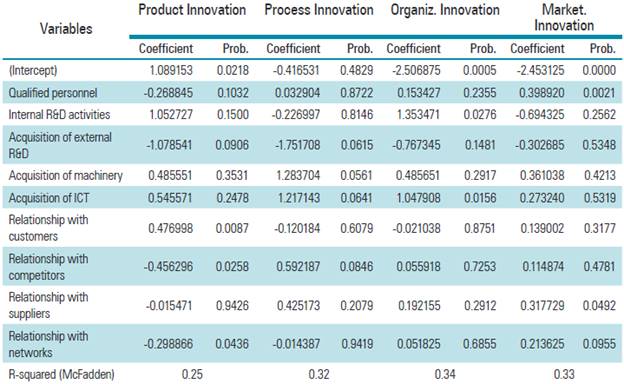1. INTRODUCTION
Innovation has been studied worldwide for decades from different perspectives due to its multidimensional nature (Dodgson et al., 2014). Nevertheless, most studies have focused on developed economies, having less emphasis on emerging ones, such as Latin America, which has only been studied according to expenses of R&D, innovative performance and firms’ profit (Heredia-Perez et al., 2019). As such, there is a gap in the research for the process of innovation in emerging markets (Becheikh et al., 2006; Geldes et al., 2017). Moreover, Latin America’s innovation studies were initiated late and still present a marginal contribution to the field (Ketelhöhn & Ogliastri, 2013). In fact, these studies have been developed later than those of the United States and Europe (Tello-Gamarra et al., 2018). These authors in their bibliometric analysis find that Latin America still lags behind the reference countries, due to accounting for only 2.75% of the entire bibliography for innovation. Innovation in these countries mostly occurs through the absorption, adaptation and mastery of already existing technologies, which came from abroad, rather than the invention of new technologies inside (Goedhuys & Veugelers, 2012).
Business innovation-related literature is extensive, including different perspectives at the firm, industry, and regional levels (Teece, 2007; Cooke, 2008; Malerba & Adams, 2014). Many of internal and external factors have influenced the innovation process. For example, qualified personnel, investments in R&D activities, supply of machinery, acquisition of ICT, cooperation with customers, competitors, and suppliers among other external actors (Becheikh et al., 2006; Tidd & Bessant, 2013). Therefore, it is relevant to identify explanatory variables that determine the innovation outcomes (Seclen-Luna & Barrutia-Güenaga, 2018).
In order to shed more light on the enabler factors for innovation outcomes, this study analyses micro-evidence from a group of innovative Peruvian firms. In recent years, although Peru has been lagged in the ranking of innovation at the Global Competitiveness Report (World Economic Forum, 2018), Peruvian governmental bodies promote innovation through several policy instruments, which have increased considerately during the last seven years, according to the National Council for Science, Technology and Technological Innovation (CONCYTEC, 2018). For example, the Peruvian Ministry of Production promotes the competitiveness of Peruvian firms. One way to achieve these goals is through the financing of innovative projects, to deploy new products or processes, and its subsequent successful introduction into the market (Seclen-Luna & Ponce-Regalado, 2018).
This study contributes to the theory of innovation processes (Heredia-Pérez et al., 2019) in the Peruvian context by reinforcing the assumption that resources for innovation and the sources of innovation are factors that influence innovation outcomes by using econometric regressions. This research shows how these factors are related with innovation outcomes and with product innovation, highlighting that the scarcity of qualified personal and the lack of funds in the company can be influenced.
The paper is structured as follows: first, we establish a theoretical framework explaining the relationship between enabler factors and innovation outcomes. Next, we carry out an empirical study to test these assumptions and discuss the results. Finally, we explain these relationships in the Peruvian innovative firms that were financed with public funding to carry out an innovation project.
2. LITERATURE REVIEW AND HYPOTHESIS
2.1 Innovation Outcomes.
Based on the Oslo Manual (OCDE & EUROSTAT, 2005) innovation can be understood as either a final product or as a process that makes it possible to combine the technical, financial, productive, organizational and commercial capabilities to create or improve a product. Following the previous argument, innovation outcomes are understood as those outputs that result after the deployment of innovation activities. In this way, the main innovation outcomes are seen as product innovations (new or relevant improvements in specification techniques, design, use of materials, components, etc.); process innovation (new or improved processes, the implementation of new machinery and the incorporation of quality systems, etc.); organizational innovation (new organizational methods for firms’ management, such as new ways to manage human talent or culture in their business model or even their external relations); innovation in commercialisation or marketing (new methods to respond to clients’ needs, such as new channels of sales, prices, design or packaging).
These innovation outcomes can be influenced by several internal and external interactions. For example, the internal dimensions of innovation are related to activities (such as R&D investment) and elements (such as resources, dynamic capabilities and competencies) within the firm that lead to innovation (Fagerberg et al., 2010; Teece, 2010). In this way, these internal activities and resources are constantly influenced by external factors (Becheikh et al., 2006). In addition, factors that influence the developing of new technological capabilities for firms are related to firms’ internal features such as absorptive capacity, business model, external features such as firms’ networks, and institutional environment, and even more so in emerging markets contexts (Petti & Zhang, 2011).
2.2 Enabler Factors to Innovation.
This study has an approximation to innovative capacities as suggested by Heredia- Pérez et al., (2019) who consider the resources for innovation and sources of innovation as key factors to the innovation process in emerging countries.
The resources for innovation (innovation capacity) have been used from different perspectives and have been related to several factors, such as the human factor, knowledge and organization (Martínez-Román et al., 2011). The human dimension includes the educational level of workers (McGuirk et al., 2015; Yuqian & Dayuan, 2015; Van Uden et al., 2017). Santos et al., (2014) indicates that the human factor has an important influence on innovation performance. In the same way, Feldens et al., (2012), determined that the lack of skilled labour is a constraint for innovation. Furthermore, Schneider (2013) argued that this low skilled labour pushes multinational firms and business groups in Latin America towards lower levels of technology investment. In summary, the management literature has identified a high-skilled labour force as a very important dimension of the innovation processes at the firm level (Fonseca et al., 2019; Ma et al., 2019; Sun et al., 2020). These authors introduce an alternative perspective of human capital based on the tasks that firms’ workers perform, and conclude that it influences a firm’s propensity to innovate as well as its product innovation performance. Moreover, while firms increasingly are adopting open models for innovation and engage with external knowledge sources, they find that they need to attract new groups of qualified employees to the innovation process as well (Laursen & Foss, 2014).
The knowledge dimension includes all internal activities carried out within the firms to create new knowledge, like research and development activities. Moreover, it includes the acquisition of external knowledge, machinery supply, acquisition of ICT, etc. (Seclen-Luna & Barrutia-Güenaga, 2019). Mairesse & Mohnen (2010) explained how efforts for developing internal R&D competencies represent the most often reported explanation of innovation output. In addition, Catozzella & Vivarelli (2014) indicate that internal R&D acts as an input to the innovation process (being useful in developing new products and manufacturing processes), and that R&D is a catalyst that accelerates “reactions” within an innovative process by improving the individual resources’ features. This interacts, creating absorptive capacity into a developed environment (Becheikh et al., 2006). However, this can be different in an underdeveloped environment. For example, formal companies reduce their investments in R&D when the intellectual property environment is low-developed (Heredia-Pérez et al., 2019).
R&D internal investment help firms to capitalize on external sources of innovation, following the theory of absorptive capacity stated by Cohen and Levinthal (1990) and reinforced later by Mowery, Oxley & Silverman (1996). On the other hand, a technology-acquisition strategy based on industrial technology and equipment acquisition, can show a negative effect on innovation output. Additionally, the innovation initiatives that concentrate investments on software procurement also generate negative results associated with innovation outputs (Germán et al., 2016). In any case, Del Carpio-Gallegos & Miralles-Torner (2018) stated that absorptive capacity favours technological and non-technological innovation capacity. In summary, the literature exhibits a positive and significant relationship between the capacity for innovation and innovation outcomes. For example, Chudnovsky et al., (2006) find that in-house R&D and technology procurement expenditures enhance the probability of product and/or process innovations, which in turn achieve higher productivity levels than non-innovators. Finally, this study recognizes resources for innovation as an approximation to innovative capacities as suggested by Martínez- Román et al. (2011). Due to these arguments, the following hypothesis is offered:
Hypothesis 1. Resources for innovation are associated with innovation outcomes.
According to Barringer & Harrison (2000), several forms of organizational relationships are capable of bringing important resources and creating different potential outcomes for firms. Becheikh et al. (2006) emphasize that a company’s external relations, cooperation alliances, and the use of external information sources, influence their ability to innovate. Few organizations, if any, can innovate standing alone, and collaboration with a select number of partners creates the complementary alliances that innovation needs, encourages learning, and allow organizations to deal with uncertainty and complexity (Dodgson, 2014). In fact, innovation happens in networks of the brain, networks of people, and networks of firms (Kastelle & Steen, 2014). Creativity and good ideas, new ways of thinking and paths for disruptive behaviour, flow from the very deep structure of collaborative groups and networks (Burt, 2004). Moreover, firms involved in alliance networks with short average paths among them have demonstrated better innovation outcomes (Schilling & Phelps, 2007). Many studies have identified several types of cooperation with customers, competitors, suppliers, and others external actors (Zeng et al., 2010), as being a key feature of an open innovation process, involving many and varied contributors (Dodgson, 2014). However, firms in developing countries are mainly collaborating on activities, since there is a lack of technological capabilities to perform R&D activities. By contrast, firms that cooperate in R&D activities seem to use their networks to strengthen a technological capability which leads them to invest more R&D, allowing them to introduce new-to-the-market product innovation (Fernandez-Sastre & Vaca- Vera, 2017; Bustinza et al., 2019) or to develop networks of learning as a reliable source of inter-firm innovation knowledge in highly technology concentrated markets (Powell et al., 1996). Additionally, Morales & Sifontes (2014) did an analysis in Latin American countries and stated that cooperation enables firms to increase technological innovation because it permits cooperative exchanges of skills. Mowery et al. (1996), who argued that strategic alliances might lead firms to the transfer of knowledge and technological capabilities as well, explained the same. This study aims to explain the identification of practices that intend to enrich the firm’s knowledge base through the integration of knowledge, resources, and expertise from external partners such as customers, suppliers, competitors and research institutes (Dahlander & Gann, 2010). Many studies have shown the positive effects derived from the implementation that collaborative innovation practices have on the generation of technological innovations. Specifically, research has shown that the probability of executing product innovations is enhanced by taking part in innovation projects with external partners (Anzola-Román et al., 2018). Based on these arguments, the following hypothesis is offered:
Hypothesis 2. Sources of innovation are associated with innovation outcomes.
Figure 1 exhibits the hypothesis formulated in a relationships model. The next section presents the methodology of the study.
3. METHODOLOGY
This research aims to contribute to the theory of innovation processes (Heredia- Pérez et al., 2019). More specifically, our purpose is to verify whether the resources for innovation and sources of innovation influence innovation outcomes of Peruvian companies that were financed with public funds to develop innovation projects.
3.1 Sampling Procedures
One of the main barriers to conducting studies on innovation in Peruvian companies is the lack of databases with up-to-date contact information, the lack of confidence and the lack of diffusion of the innovation topic (Yrigoyen, 2013). The strategy to reduce this obstacle was to contact institutions that have developed a bond of trust with these companies. In this way, in order to ensure that the companies under study are innovative, we selected those Peruvian companies that were financed with public funds to carry out an innovation project. According to Innóvate Perú (executing agency of the Ministry of Production of Peru), the PIPEI, PITEI, PIMEN and PIPEA programs aim to strengthen the technological capacity for innovation in companies through the financing of innovation projects for creation of a new product or process and, its successful introduction into the market (Seclen-Luna & Ponce-Regalado, 2018). During the period from 2013 to 2015, 107 companies completed their respective innovation projects that were financed by these programs throughout Peru. The sample obtained was 84 companies (Table 1).
To verify the hypotheses proposed, the empirical research was based on a probabilistic sampling of surveys containing questions that focus on the general characteristics of the companies, such as the type of property, manager’s characteristics, number of workers, etc. In addition, other questions refer to innovation at the company, where attention is paid to the reasons why companies carry out innovation activities, as well as to the different types of expenses related to innovation, and the innovations outcomes obtained from 2013 to 2015. The collection process of the information was from April to July 2017. At first, the survey was designed and tested in a pilot test with 10 companies, after which it was validated by national and international experts. The surveys were sent by email, addressed to the company manager or the director of R&D, obtaining a response rate of 78%.
3.2 Variables and Scales
In this research we consider the innovation outcomes as a final product (Acs & Audretsch, 2010). Therefore, we measure it as the innovations obtained (product, process, organizational and marketing) after having carried out innovation activities (OCDE & EUROSTAT, 2005). Table 2 show the variables of the model. In terms of reliability and validity of the internal consistency, Cronbach’s alpha value of α = 0.693, indicates a moderate reliability level of internal consistency among the variables utilized to build the econometric regressions of the model. More specifically, Cronbach’s alpha for product innovation was α = 0.682, process innovation α = 0.692, organizational innovation α = 0.710, and marketing innovation α = 0.713.
4. RESULTS AND DISCUSSION
4.1 Descriptive Statistics
The main characteristics of the companies analysed are that they have an average of 56 workers, and 61% of them are family-type companies. Likewise, regarding the profile of the manager of the companies analysed, we find that they are mostly men (83%), with completed university studies (81%) and that they have an average age of 49 years. Furthermore, the main reason these companies innovate is due to the need for survival and the requirement of customers. However, for these companies it seems that both, technical regulations (62%) and public policies (61%), are not perceived as a driver of innovation, compared to customers’ needs. Additionally, we find that the decision-making driver to innovate relies on the company manager (83%) and finally, the companies are made up of an average of 5 employees dedicated to innovation activities (Seclen-Luna & Ponce-Regalado, 2018).
Table 3 shows the descriptive statistics and is clear to note that most of the firms carried out process innovation followed by product innovation. That is, the firms analysed prefer technological innovation. This is in accordance with the National Survey of Innovation in Manufacturing Industry of Peru, where the Peruvian companies are more oriented to the technological innovation (INEI, 2017).
4.2 Hypothesis Contrast
One way to test the hypotheses is to analyze the relationship through a binary choice econometric model, by using the binary probit method by Eviews (Table 4). Fundamentally, we use the Binary Probit because the data are cross-sectional, and the dependent variable is binary. Then, the following binary econometric model is proposed:1
Regarding this information, the variables of resources for innovation considered in the model could explain the probability of innovation outcomes. However, it is necessary to be more specific. Internal R&D activities and acquisition of ICT have influence on organizational innovation. Moreover, qualified personal has influence on marketing innovation. These results are consistent with Fonseca et al., (2019) who find the tasks that firms’ workers perform influences a firm’s propensity to innovate, and on its product innovation performance.
Furthermore, acquisition of external R&D has a certain influence on product innovation (at 10% level of significance), as well as acquisition of external R&D, and machinery and ICT have a certain influence on process innovation. These findings coincide with the results of the National Survey of Innovation in the Manufacturing Industry of Peru, where 72.3% of investment of the Peruvian companies is in acquisition of capital goods (INEI, 2017). Therefore, the hypothesis 1, is partially accepted.
On the other hand, the relationship with customers, competitors and networks has influence on product innovation. Moreover, the relationship with suppliers have influence on marketing innovation. In addition, relationship with competitors have certain influence on process innovation (at 10% level of significance). Thus, hypothesis 2, is partially accepted.
5. CONCLUSIONS, LIMITATIONS AND FUTURE RESEARCH
This paper contributes empirically to the theory of innovation processes (Heredia- Pérez et al., 2019) in the Peruvian context by reinforcing the assumption that resources for innovation and the sources of innovation are enabler factors that influence innovation outcomes.
Essentially, the resources for innovation are related to non-technological innovation. However, it is important to highlight that while the acquisition of external R&D, machinery and ICT are the activities that are least carried out by Peruvian firms, they have relationships with process innovation (at 10% level of significance). Conversely, internal R&D is one of the activities that most companies carry out, nevertheless, it does not present a relationship with either product or process innovation, that is, with technological innovation. In this way, it is corroborated with what largely occurs related to innovation in the Latin American through the absorption, adaptation and mastery of technologies already developed elsewhere, and usually sourced from abroad, rather than the invention of disruptive new technologies from the inside (Goedhuys & Veugelers, 2012).
Moreover, it is important to note that the sources of innovation are related to product innovation, although the collaboration with customers, competitors and networks is still scarce in these companies, even when it allows cooperative exchanges of skills. In this way, opportunities to increase technological innovation could be lost (Morales & Sifontes, 2014).
These results have important implications for practitioners. They can point out that the company’s managers in Peru must promote and reinforce their resources for innovation while looking for more linkages with external actors (Becheikh et al., 2006). Particularly, they should engage in relationships with competitors and networks. Therefore, the equilibrium between non-technological and technological innovations is key (Geldes et al., 2017; Seclen-Luna & Barrutia-Güenaga, 2019). Meanwhile, policy makers should encourage companies with more adequate mechanisms for financial resources, and assure a pool of high qualified personal in their territory or region to promotes innovations processes in their companies. Moreover, they should build and implement accurate indicators for the innovation processes (Dziallas & Blind, 2019).
Although these results are useful for their implications for business managers and policy makers, since it advances knowledge regarding the innovation process in the Peruvian context, this study has limitations that suggest future research. Firstly, owing to fact that the sample is made up of innovative companies financed by public programs, these results cannot be generalized, so they should be taken with some caution. Secondly, as the study was carried out in 2017, it does not capture new definitions for measuring the business innovation from the Oslo Manual (OECD & EUROSTAT, 2018). Finally, because the analysis carried out in this study is of a cross-sectional nature, it leads to a failure in capturing all of the dynamics of the innovation process. As such, it would be advisable to carry out further longitudinal studies (Heredia-Pérez et al, 2019), which may be complemented by a qualitative analysis, in order to improve understanding of the innovation process (Seclen-Luna & López-Valladares, 2020). It would also prove valuable to carry out comparative studies using different Latin American countries, which could assist governments in improving their policies while promoting innovation developments (Del Carpio- Gallegos & Miralles-Torner, 2018).













